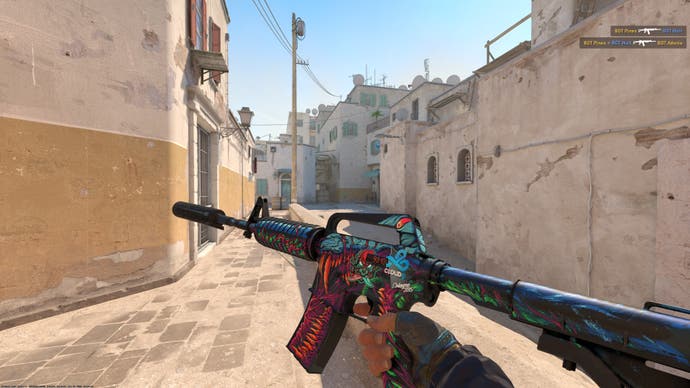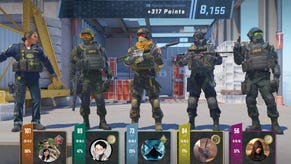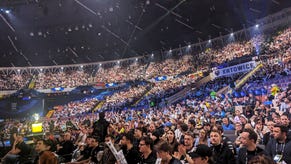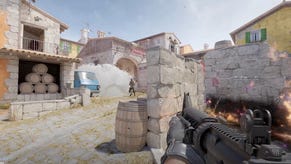Counter-Strike 2 is already a blast - and lays the groundwork for years to come
No smoke without fire.
I'm excited. I've been playing Counter-Strike: Global Offensive for 11 years now, since its release in 2012, and it's gone from being a LAN party curio to my go-to game I've sunk literally thousands of hours in, whether I'm testing hardware or testing my mettle in its online matchmaking. I'm joined online by 1.5 million concurrent players, and even when I take a break from playing, I follow the thrilling competitive scene that awards millions of dollars in prize money to its participants each year – not bad for a slow-paced, strategic shooter series that started life as a Half-Life mod in 1999.
The game has continued to develop and evolve all this time, but for the last few years developer Valve has been quiet – no new operations, Counter-Strike's take on a battle pass, have been released, once-frequent weapon balance tweaks have ceased, and updates of any kind have slowed to a crawl. That's because, since Half-Life Al was released in 2020, Valve has been secretly working on a new Counter-Strike: Counter-Strike 2. I've been taking part in the game's Limited Test, and despite some technical failings typical of pre-release software, I'm having a blast.
We'll take a closer look at Counter-Strike 2's technical changes in a Digital Foundry analysis soon, but the basics are the game ditches the old Source engine, based on DirectX 9 and originally released in 2012, for Source 2 and the modern Vulkan graphics API. Source 2 launched for Dota 2 in 2015 and a souped-up version powered Half Life Al in 2020, so it's hardly brand new, but clearly the development effort to rebuild a game more than a decade old in a new engine was substantial.
With this new foundation in place, the way for future upgrades and improvements ought to be clear – and Counter-Strike 2 is expected to launch this summer with enough new features to justify the new numeral. The three big ticket items are dynamic, volumetric smoke grenades, which realistically fill spaces and can be shot or grenaded to temporarily carve gaps; a new lighting model that combines with upgraded assets like maps, weapons and agents to improve graphical fidelity; and a 'tickless' networking model that trades the old rigid 64-tick update rate for one that sends shots, grenade throws or movement micro-seconds after it occurs. Other elements, like the user interface and blood spatters, have also been reworked so CS2 feels like a fresher, more modern game, befitting its 2023 release date and a packed roster of alternative shooters like Valorant, Fortnite and Warzone 2.
At the moment CS2 is available as a limited test for a small percentage of active Counter-Strike: Global Offensive players, with only a single map – the classic de_dust2 – and two game modes, deathmatch and competitive, available. Dust 2 is very much the quintessential Counter-Strike map, so it's a fine choice – and as it's set only to receive lighting updates rather than physically-based material upgrades or a full rework, it's also one of the easiest maps for Valve to provide at this early stage.

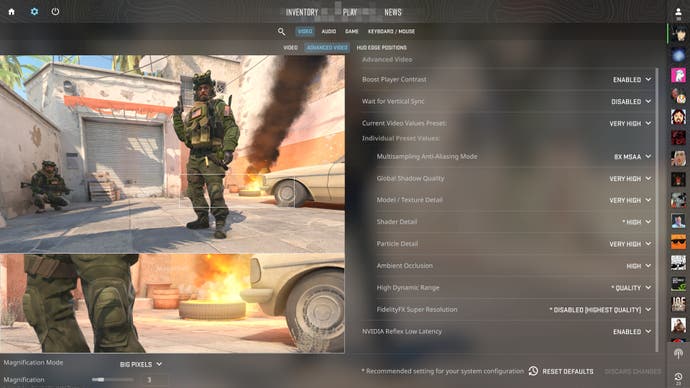
I've played through around half a dozen competitive matches and the same number of DM rounds, and already it's clear the new features upgrade the game in meaningful ways. The new smoke grenades are the highlight here, offering game-changing impact when players use them tactically to reveal an enemy player unexpectedly, offering up scenarios for play and counter-play. The new tickless networking also feels fantastic, with shots that feel fairer – if you missed, it was on you, not some weirdness you can blame on the server or another person's connection. Unexpectedly though, movement feels a little worse; it's sometimes hard to nail jumps or bunny hop, but at least the act of flinging a grenade at the top of your jump or nailing someone through the head with a Desert Eagle feels perfect every time.
There are a ton of subtle quality of life changes too. You can see your own legs; the minimap shows where on the map you can be heard; enemies can now rag-doll on top of each other instead of clipping through each other; taking a bullet produces a directional blood effect to clue you in to the shooter's location; molotovs cocktails produce huge pink-orange gouts of flame when thrown and use the same realistic fluid-sim shader as Half-Life Al; sounds have been reworked with more prominent environmental effects; and equipping a grenade in practice mode provides a picture-in-picture view of exactly where the grenade will land if thrown. It's all great stuff, and it really feels like the combined output of at least three years of ideas and experimentation.
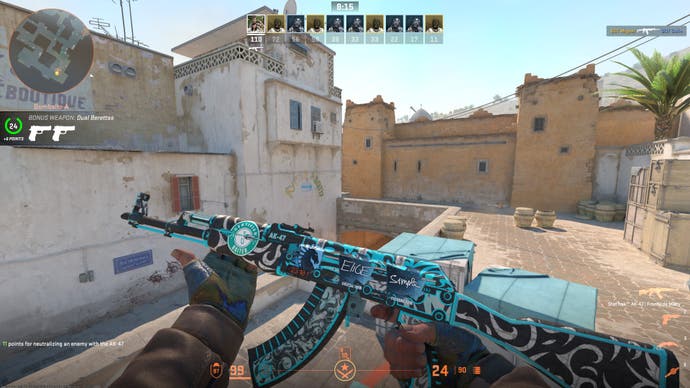

The only true issues I've run into have been technical ones. The game has broken in some truly weird ways even in the very few days I've had access. Sometimes the sound stops working after a round, only returning after 20 seconds in the menu changing output devices; other times, my keyboard, headset and mouse will stop working entirely, requiring a full system reboot to restore – yet the game continues to run, with my teammates getting increasingly exasperated with my inactivity. Performance is also a bit of a mixed bag – I'm getting around 200 to 400fps at 4K max settings, which sounds good even with a top-tier RTX 4090 GPU and Core i7 12700K CPU, but dropping settings to their lowest options doesn't claw back much performance. Still though, it's early days and there's plenty of time for Valve to improve frame-rates and fix bugs.
While the changes already in place are impressive, it's the stuff yet to come I'm most excited about. For years, it's felt that Counter-Strike's development has been slowed by its age, with new features made more challenging to implement by its calcified code base, a decade of changes built on a now ancient graphics API. With CS2, that cruft ought to have been wiped clean, and that could mean Valve are free to produce meaningful changes at a much faster rate. New maps, new weapons, new game modes, new graphical features; there's a universe of possibilities out there.
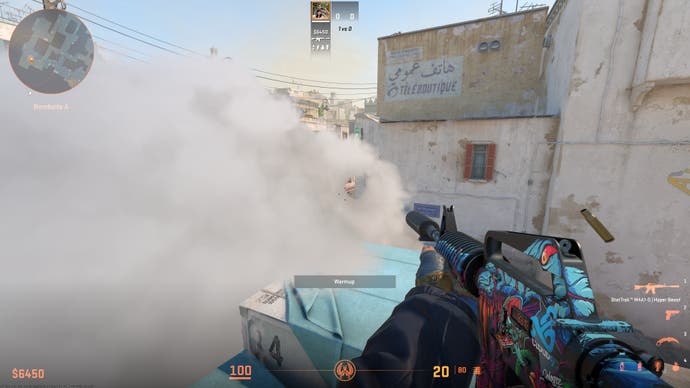

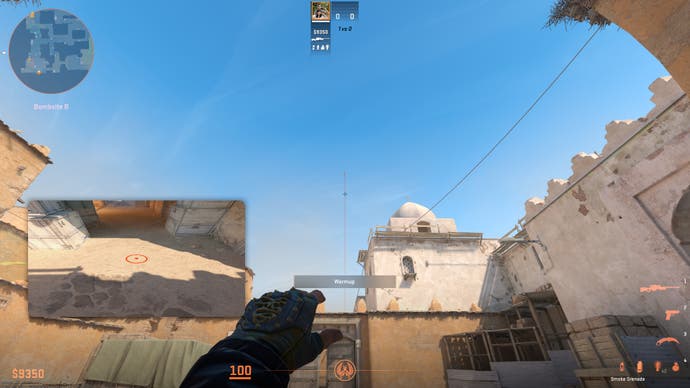
And for all of the changes we've seen so far, CS2 very much keeps the essence of Counter-Strike: Global Offensive, and that's correct. There's no need to make major changes to a game currently setting player count records and enjoying a thriving esports scene. Instead, the focus is on making some fun tweaks to the formula, things that conceivably could have come one-by-one in regular game updates if the Source 1 engine at the heart of the game would have allowed it, but it didn't, seemingly, so instead Valve needed to spend three years doing the legwork behind the scenes to reinstitute Counter-Strike’s foundation.
It can be instructive to contrast the methodical, iterative mindset behind Counter-Strike 2 with that responsible for Battlefield 2042, which faltered on launch because of its diversions from the classic Battlefield formula in pursuit of features largely lifted from other games, like named agents, pick-anything weapon loadouts and ever-larger player counts rather than class-based combat, characterful maps and more meaningful progression. Most of these changes have since been walked back, vindicating the feedback of external playtesters as early as the open beta.
Valve didn't just magically stumble upon the right solution though. Global Offensive was actually its 2042 moment, a new and shiny game aimed at a broader audience – console players! – that launched to minimal uptake. Valve had to slowly change its focus to its enthusiast PC player base, fixing issues and making improvements until it converted a critical mass of 1.6 and Source holdovers. Now, with that lesson learned – and with the time and space to iterate and experiment – Counter-Strike 2 is on a promising trajectory indeed.
